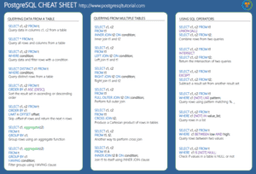 The PostgreSQL cheat sheet provides you with the common PostgreSQL commands and statements that enable you to work with PostgreSQL quickly and effectively.
The PostgreSQL cheat sheet provides you with the common PostgreSQL commands and statements that enable you to work with PostgreSQL quickly and effectively.
Download the PostgreSQL cheat sheet
We provide you with a 3-page PostgreSQL cheat sheet in PDF format. You can download and print it out for a quick reference to the most commonly used statements in PostgreSQL:
Download the PostgreSQL Cheat Sheet
PostgreSQL commands
Access the PostgreSQL server from psql with a specific user:
psql -U [username];For example, the following command uses the postgres user to access the PostgreSQL database server:
psql -U postgresConnect to a specific database:
\c database_name;For example, the following command connects to the dvdrental database:
\c dvdrental;
You are now connected to database "dvdrental" as user "postgres".To quit the psql:
\qList all databases in the PostgreSQL database server
\lList all schemas:
\dnList all stored procedures and functions:
\dfList all views:
\dvLists all tables in a current database.
\dtOr to get more information on tables in the current database:
\dt+Get detailed information on a table.
\d+ table_nameShow a stored procedure or function code:
\df+ function_nameShow query output in the pretty format:
\xList all users:
\duCreate a new role:
CREATE ROLE role_name;Create a new role with a username and password:
CREATE ROLE username NOINHERIT LOGIN PASSWORD password;Change the role for the current session to the new_role:
SET ROLE new_role;Allow role_1 to set its role as role_2:
GRANT role_2 TO role_1;Managing databases
CREATE DATABASE [IF NOT EXISTS] db_name;Delete a database permanently:
DROP DATABASE [IF EXISTS] db_name;Managing tables
Create a new table or a temporary table
CREATE [TEMP] TABLE [IF NOT EXISTS] table_name(
pk SERIAL PRIMARY KEY,
c1 type(size) NOT NULL,
c2 type(size) NULL,
...
);Add a new column to a table:
ALTER TABLE table_name ADD COLUMN new_column_name TYPE;Drop a column in a table:
ALTER TABLE table_name
DROP COLUMN column_name;ALTER TABLE table_name
RENAME column_name TO new_column_name;Set or remove a default value for a column:
ALTER TABLE table_name
ALTER COLUMN [SET DEFAULT value | DROP DEFAULT]Add a primary keyto a table.
ALTER TABLE table_name
ADD PRIMARY KEY (column,...);Remove the primary key from a table.
ALTER TABLE table_name
DROP CONSTRAINT primary_key_constraint_name;ALTER TABLE table_name
RENAME TO new_table_name;Drop a table and its dependent objects:
DROP TABLE [IF EXISTS] table_name CASCADE;Managing views
CREATE OR REPLACE view_name AS
query;CREATE RECURSIVE VIEW view_name(column_list) AS
SELECT column_list;CREATE MATERIALIZED VIEW view_name
AS
query
WITH [NO] DATA;Refresh a materialized view:
REFRESH MATERIALIZED VIEW CONCURRENTLY view_name;Drop a view:
DROP VIEW [ IF EXISTS ] view_name;Drop a materialized view:
DROP MATERIALIZED VIEW view_name;Rename a view:
ALTER VIEW view_name RENAME TO new_name;Managing indexes
Creating an index with the specified name on a table
CREATE [UNIQUE] INDEX index_name
ON table (column,...)Removing a specified index from a table
DROP INDEX index_name;Querying data from tables
Query all data from a table:
SELECT * FROM table_name;Query data from specified columns of all rows in a table:
SELECT column_list
FROM table;Query data and select unique rows:
SELECT DISTINCT (column)
FROM table;Query data from a table with a filter:
SELECT *
FROM table
WHERE condition;Assign an alias to a column in the result set:
SELECT column_1 AS new_column_1, ...
FROM table;Query data using the LIKE operator:
SELECT * FROM table_name
WHERE column LIKE '%value%'Query data using the BETWEEN operator:
SELECT * FROM table_name
WHERE column BETWEEN low AND high;Query data using the IN operator:
SELECT *
FROM table_name
WHERE column IN (value1, value2,...);Constrain the returned rows with the LIMIT clause:
SELECT *
FROM table_name
LIMIT limit OFFSET offset
ORDER BY column_name;Query data from multiple using the inner join, left join, full outer join, cross join and natural join:
SELECT *
FROM table1
INNER JOIN table2 ON conditionsSELECT *
FROM table1
LEFT JOIN table2 ON conditionsSELECT *
FROM table1
FULL OUTER JOIN table2 ON conditionsSELECT *
FROM table1
CROSS JOIN table2;SELECT *
FROM table1
NATURAL JOIN table2;Return the number of rows of a table.
SELECT COUNT (*)
FROM table_name;Sort rows in ascending or descending order:
SELECT select_list
FROM table
ORDER BY column ASC [DESC], column2 ASC [DESC],...;Group rows using GROUP BY clause.
SELECT *
FROM table
GROUP BY column_1, column_2, ...;Filter groups using the HAVING clause.
SELECT *
FROM table
GROUP BY column_1
HAVING condition;Set operations
Combine the result set of two or more queries with UNION operator:
SELECT * FROM table1
UNION
SELECT * FROM table2;Minus a result set using EXCEPT operator:
SELECT * FROM table1
EXCEPT
SELECT * FROM table2;Get the intersection of the result sets of two queries:
SELECT * FROM table1
INTERSECT
SELECT * FROM table2;Modifying data
Insert a new row into a table:
INSERT INTO table(column1,column2,...)
VALUES(value_1,value_2,...);Insert multiple rows into a table:
INSERT INTO table_name(column1,column2,...)
VALUES(value_1,value_2,...),
(value_1,value_2,...),
(value_1,value_2,...),
...;Update data for all rows:
UPDATE table_name
SET column_1 = value_1,
...;Update data for a set of rows specified by a condition in the WHERE clause.
UPDATE table
SET column_1 = value_1,
...
WHERE condition;Delete all rows of a table:
DELETE FROM table_name;Delete specific rows based on a condition:
DELETE FROM table_name
WHERE condition;Performance
Show the query plan for a query:
EXPLAIN query;Show and execute the query plan for a query:
EXPLAIN ANALYZE query;Collect statistics:
ANALYZE table_name;